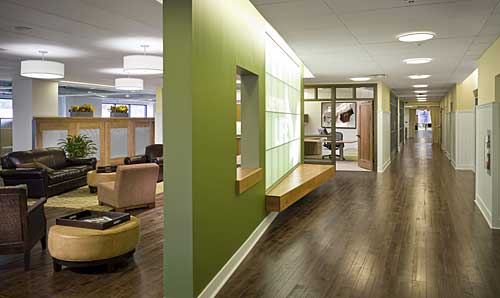American Hardwoods for High-Traffic Areas
Learning Objectives:
- Evaluate the suitability of specifying American hardwoods in high-traffic settings
- Explain how life-cycle thinking influences green building products selection
- Consider appropriate finishes for hardwoods in different settings
- Discuss economic considerations for hardwood maintenance and care
Credits:
Hardwood floors have been around for centuries, prized for their longevity, durability and wear-resistance. It's no accident that trains run on oak rail ties, or that professional basketball is played on maple courts. Because of their inherent strength, as well as the fact that they have some "give" to them and are not tiring underfoot, hardwood floors are frequently specified in high-traffic settings -from stores to hospitals to museums-that log in millions of visitors a year. Advancements in chemical technology have generated surface and penetrating treatments that add to hardwoods' natural durability. The result is floors that, with proper maintenance, can outlast most other available flooring materials. And when factors beyond initial purchase price and installation are considered, hardwoods actually prove to be one of the least expensive flooring options. This article will discuss the suitability of various hardwood species for high-traffic settings, as well as key design considerations including finishes and maintenance.
Hardwood Basics
Hardwoods are deciduous trees that have broad leaves, produce a fruit or nut and generally go dormant in the winter. America's forests grow hundreds of varieties of hardwood trees that thrive in this country's temperate climates. These varieties, or species, include oak, ash, cherry, maple and poplar. Each hardwood species has unique physical properties, and when it comes to hardness, the U.S. species vary widely. For example, the hardest commercially available hardwood is hickory, and it is five times harder than aspen, one of the "soft hardwoods."
|
The relative hardness of woods is measured by the Janka Rating System which measures the force required to drive a .444-inch steel ball into the wood, so that half the diameter of the steel ball is embedded. The higher the number, the harder the species of wood.
Red oak, which has a Janka rating of 1290, is the industry benchmark for comparing the relative hardness of different wood species.
Although the higher the Janka rating, the harder the wood, don't mistake hardness for the best wood. In addition to a wood's hardness, other qualities to consider when choosing a wood floor include both aesthetic and physical properties.
|
||||||||||||||||||||||||||||||||||
Hardwoods are also graded for quality. The National Hardwood Lumber Association (NHLA) grading system, which is used by buyers and sellers of hardwood lumber, describes the amount of "usable" clear material in a board. The highest grade boards are long, wide and free of defects. There are eight hardwood lumber grades, with Firsts and Seconds (FAS) being the highest and No. 3B Common, the lowest. Generally speaking, the higher grades of lumber have more large clear area than the lower grades.










